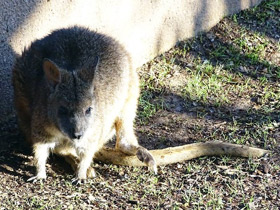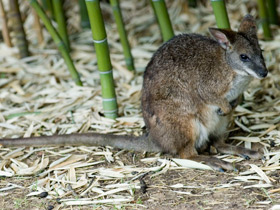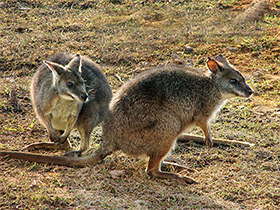The parma wallaby (Notamacropus parma)
The parma wallaby (Notamacropus parma) is a small marsupial macropod mammal native to forests and densely-vegetated areas of northeastern New South Wales, Australia, close to the border with Queensland. There is also an introduced population found in and around Rodney District, just north of Auckland, New Zealand. About the size of a stout cat, it lives mainly under thick plant cover, and is only active at night when it emerges to feed on grasses and small plants. It is the smallest of the wallabies (short, kangaroo-like marsupial mammals of the genus Notamacropus) and carries its young in a pouch, as with other marsupials. Shy and elusive, it was believed extinct until its rediscovery in the 1960s.
Parma wallabies are threatened by habitat loss, and, in addition to native predators (such as birds of prey, monitor lizards, and snakes), they are easily preyed upon by dingoes and non-native feral cats and red foxes.
Taxonomy
The parma wallaby was first described by British naturalist John Gould in about 1840. Its epithet parma (Waterhouse 1845) comes after a word from a New South Wales Aboriginal language, but the exact source word and language have not been identified.
In 2019, a reassessment of macropod taxonomy determined that Osphranter and Notamacropus, formerly considered subgenera of Macropus, should be moved to the genus level. This change was accepted by the Australian Faunal Directory in 2020.
Distribution
Macropus parma is a species of marsupial diprotodon in the family Macropodidae. It is a shy animal that hides in the sclerophyllous rainforests of southern New South Wales, Australia.
Macropus parma is so rare that for a time it was even considered extinct. It was discovered in 1840 by the British naturalist John Gould. At that time, this small member of the giant kangaroo family lived in the rainforests of New South Wales. At the end of the 19th century, the white-breasted kangaroo was unheard of in the wild and was therefore considered an extinct species.
Fortunately, however, in 1965 a miraculously surviving population of the little kangaroo was discovered on Kawau Island, not far from Auckland. Interestingly, its discovery was entirely accidental: it was at a time when the Eugenia kangaroo population on the island was being reduced, which had to be urgently halted due to new developments. All Macropus parma were recaptured and sent to scientific institutions. The plan was to breed them in captivity and send them back to their natural habitat. However, two years later, these agile little guys were also found on the Australian continent itself. It turned out that Macropus parma live quite happily in the forests of the Great Dividing Range.
Appearance and conservation status
Macropus parma prefers to hide in dense thickets and keep out of sight of humans. At present, Macropus parma remains rare and is listed as Near Threatened on the IUCN Red List. However, there is hope for the population's recovery: its main habitats have finally been protected and the numbers of these small kangaroos are gradually increasing.
The adult Macropus parma weighs only 3.2-5.8 kg (one tenth the weight of its larger companion, the great red kangaroo). Its body length is no more than half a metre, and the same is true of its long, muscular tail. Wallabies have white stripes on their cheeks and a white chest and throat. The rest of the coat is brown with a red or grey tinge. From the shoulder to the middle of the back there is a dark stripe, which is also considered a peculiarity of the species. Interestingly, the offspring of Kawau white-breasted wallabies are considerably smaller than their mainland relatives. Even when well fed, they never reach their size. This appears to be the result of natural selection: smaller individuals found it easier to survive on an isolated island.
Social behaviour and reproduction
Unlike other kangaroo species, Macropus parma is a solitary species. They are only found during the breeding season, which lasts from May to July. On seeing a potential mate, the male Macropus parma makes characteristic noises and begins courtship. Then, with his forelegs, the male presses the female's head against his chest and mating takes place. Pregnancy lasts between 33 and 35 days. As she feels the onset of labour, the female carefully licks her pouch, preparing it for the baby to be born. The Macropus parma calf remains in the pouch for about 30 weeks and then gradually begins to explore its environment. A second calf is born soon after, but the older one continues to suckle until it is 11 months old. At 16 months of age, female Macropus parma are able to reproduce. Males take a little longer: 20 to 24 months.
Status
The species remains rarely seen, with some evidence for a recent population decline. It is classified as Near Threatened according to the 2015 IUCN assessment.


















































